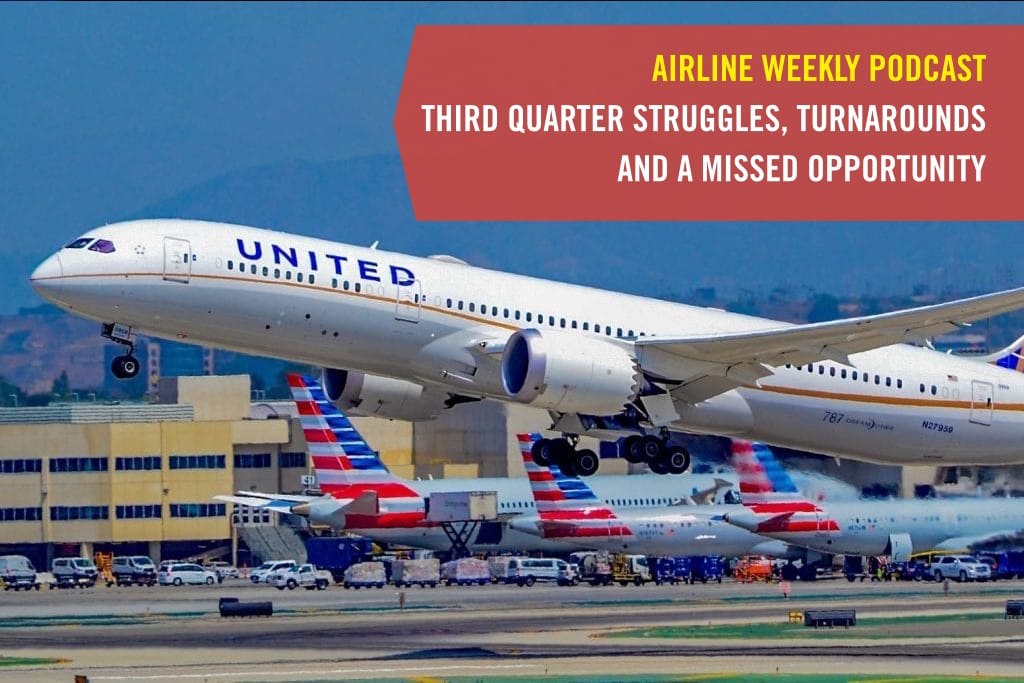Skift Take
With fuel costs rising 37 percent in the U.S. airline sector, you might expect airline earnings to be declining — and they certainly did in the third quarter. But exceptionally strong demand enabled some U.S. airlines to make their story more about revenue than costs.
Generally speaking, the U.S. airline market in the third quarter continued what’s been a half-decade romp. But unlike a couple of years ago, rising costs are certainly adding some flies to the picnic.
For U.S. carriers, the third quarter is the peak quarter, and nearly every sizable carrier reported a profit. All but a few delivered double-digit profit margins — still excellent margins for the airline industry — and some maintained high double-digit margins. These are impressive feats when fuel costs increased as much as 64 percent for some airlines. Still, the quarter wasn’t without its share of drama.
Skift recently expanded its aviation coverage with the acquisition of the 14-year-old Airline Weekly newsletter, which also delivers a podcast every two weeks. In a recent episode of The Airline Weekly Lounge, Airline Weekly editors Seth Kaplan and Jason Cottrell discussed which airlines surprised and which disappointed.
Here are five takeaways from the conversation:
United might be turning the corner.
During most of this current golden age for U.S. airlines, United has been a bit of a problem child, routinely lagging its peers in profits. But in the second half of 2016, United hired the highly respected Scott Kirby to be United’s president just moments after he left that job at American. The airline’s financial performance didn’t meaningfully improve right away, but things have changed in 2018. United in its third quarter managed to hold onto its profits in the face of rising costs better than almost all its peers (better even than Delta in that regard, even though Delta remains the more profitable airline). And United’s second quarter had a similar story. United is generating terrific revenues and, it appears, finally living up to its potential.
American’s lousy quarter seems temporary.
American Airlines had a rough quarter, posting an operating profit margin of just 7.5 percent. That compares to 11.1 percent for United and 13.7 percent for Delta, and it’s down from 12 percent in the year-before quarter. The Airline Weekly Lounge hosts love (seriously, “love” is right word here) talking about operating profit margin because they say— incessantly — it’s the best metric to compare airlines of different sizes in different parts of the world. American’s problem is not with costs, which were comparable to everyone else’s. Instead, revenues were hampered by a few things: AA’s outsized exposure to South America’s shaky economy, a mishandled bag restriction, hurricanes, messy operations, a Philadelphia hub under attack from Frontier, and delayed joint ventures with Qantas and LATAM. Most of these things should improve with time, and AA’s results could too. Interestingly, AA seems to be — even if only modestly — doing the opposite of what United is doing at its hubs (not packing “banks” of flights as tightly together in AA’s case).
Spirit is having a revival.
In its heyday, Spirit (never mind what some passengers thought of its service) was the gold standard for U.S. airline profits. But in recent years and as recently as the second quarter of 2018, Spirit had a middle-of-the-pack operating profit margin. That changed in the third quarter, when Spirit surprised with a 16.1 percent margin, just a smidge less than Hawaiian’s leading 16.6 percent and well ahead of the next closest, which was Southwest’s 14.7 percent. Spirit was the only airline to fully maintain its year-over-year margin (even United slipped fractionally) and did so while operating costs increased 32 percent. Spirit does well when ticket prices are high across the industry, and they’ve been rising lately.
JetBlue continues to struggle.
JetBlue’s margins have been tumbling this year, and that continued in the third quarter. In the second quarter its margin dropped from 19 percent last year to 9 percent this year, the biggest decline among its peers. In the most recent quarter, its margin dropped from 17 percent to just less than 10 percent. Demand and revenues are mostly fine. But JetBlue hasn’t been able to overcome cost increases as well as its competition. That won’t get any easier as JetBlue plans to slow its growth next year to 5 to 7 percent — slower growth puts upward pressure on unit costs. Compare that to the 25 percent year-over-year growth Spirit saw in its third quarter.
Southwest misses an opportunity.
Southwest had a solid quarter with an upper-echelon 14.7 percent margin. But really, the story is that it could’ve been much more, because unlike almost everybody else, Southwest was largely protected from the fuel scourge by way of its aggressive hedging. While Spirit’s fuel bill rose 64 percent, Southwest’s rose only 11 percent. Overall operating costs rose only 5 percent but revenues only rose 8 percent. If charging for bags is off the table, what can Southwest do to raise revenues?
The Daily Newsletter
Our daily coverage of the global travel industry. Written by editors and analysts from across Skift’s brands.
Have a confidential tip for Skift? Get in touch
Tags: airline innovation, airline weekly, podcast
Photo credit: United and American Airlines jets are pictured at Los Angeles International Airport in this photo from 2017. Tomás Del Coro / Flickr
